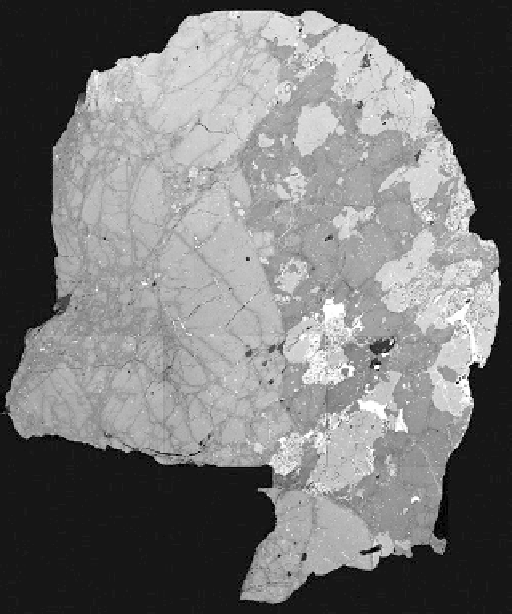Geology Reference
In-Depth Information
[
Barrat et al.
, 2007].
Floss et al.
[2000] and
Yamaguchi
et al.
[2001] have suggested that metamorphosed eucrite
EET 90020 (Plate 55) was partially melted, removing
some of its incompatible elements. This rock is then sim-
ilar to the crustal restite envisioned by
Barrat et al.
[2007]
in their model for Stannern-trend eucrite formation.
However, EET 90020 cannot be such a restite because its
Ar-Ar age indicates that partial melting of it occurred
too late in Vestan history [
Yamaguchi et al.
, 2001].
Nevertheless, some metamorphosed eucrites showing
light rare-earth-element depletions may represent such
restites [
Yamaguchi et al.
, 2009]. The Stannern trend
remains a small subset of basaltic eucrites, and half of
them are Antarctic. Thus, Antarctic basaltic eucrites
played a pivotal role in refining our understanding of the
petrogenesis of basalts on the HED parent asteroid.
Originally, diogenites were identified as orthopyroxe-
nites, and olivine was known to be a minor phase in some
[
Mason
, 1963]. Olivine-bearing diogenites were recog-
nized as having a distinct major element composition
[
Mittlefehldt et al.
, 1979]. The study of U.S. Antarctic
diogenites identified a subset of olivine diogenites sug-
gested to represent mantle restites of their parent asteroid
[
Sack et al.
, 1991]. One ANSMET diogenite was found to
be exceptionally olivine rich [
Bowman et al.
, 1997], and it
was suggested that a magnesian harzburgitic component
was present in it [
Mittlefehldt
, 2000]. This was inferred
from analyses of individual orthopyroxene and olivine
grains in the breccia; distinct harzburgite clasts were
not identified. Detailed petrologic study of ANSMET
diogenites has revealed harzburgite lithologies in some
dimict breccias and as individual meteorites, and harz-
burgitic diogenite is recognized as a subclass [
Beck and
McSween
, 2010] (Figure 5.9). Similarly, dunitic diogenite
is also a subclass defined based on an ANSMET mete-
orite [
Beck et al.
, 2011] (Figure 5.10; Plate 62). These
harzburgites and dunite are not mantle restites. Minor
element contents of the orthopyroxene and mg# trends
favor a cumulate origin [
Beck and McSween
, 2010;
Beck
et al.
, 2011].
Recent studies in which ANSMET diogenites were
critical samples have added complexities to our thinking
on HED parent asteroid evolution. Precise oxygen isotope
compositions suggest that the diogenite suite may have
been derived from at least two parent asteroids [
Day
et al.
, 2012b]. If confirmed through further work, this
result suggests that the magmatic processes that engen-
dered the HED meteorite suite may have been typical of
fully differentiated asteroids. This conclusion has already
been suggested by the findings that some basaltic achon-
drites that are petrologically and compositionally similar
to eucrites nevertheless were derived from distinct parent
asteroids because of their distinctive oxygen isotopic
compositions [cf.
Mittlefehldt
, 2005;
Scott et al.
, 2009].
Figure 5.9.
Back-scattered electron image mosaic of dimict
diogenite lEW 88679. The left side of the image is a more fer-
roan orthopyroxenite lithology. Dark veins are a cross-cutting
network of more magnesian orthopyroxene of uncertain origin.
The right side is a more magnesian harzburgite lithology
composed of orthopyroxene (dark gray) and olivine (light gray).
The mosaic is approximately 1 cm across. Image courtesy of
A. W. Beck.
Diogenites contain substantially lower radiogenic
26
Mg
formed from decay of short-lived
26
Al than do basaltic
eucrites, and this result demonstrates that they crystallized
prior to basaltic eucrite formation [
Schiller et al.
, 2011].
This was expected based on the petrologic and composi-
tional characteristics of the rocks. However, Schiller et al.
[2011] further conclude that the time scale for formation of
the diogenite and basaltic eucrite suite is too short when
considering models for the thermal evolution of Vesta.
This conundrum has yet to be explored in detail.
Diogenite petrogenesis has been difficult to fit into the
consensus model for Vestan differentiation based on
eucrites [
Mittlefehldt
, 1994;
Mittlefehldt et al.
, 2012], and
has resulted in various alternate models [
Barrat et al.
,
2010;
Shearer et al.
, 2010;
Yamaguchi et al.
, 2011].
Identification of distinct olivine-rich lithologies and
continuing compositional and isotopic investigations of
the diogenite suite allow us to more fully explore con-
straints on the HED parent asteroid geologic evolution,
an endeavor that is still evolving.

